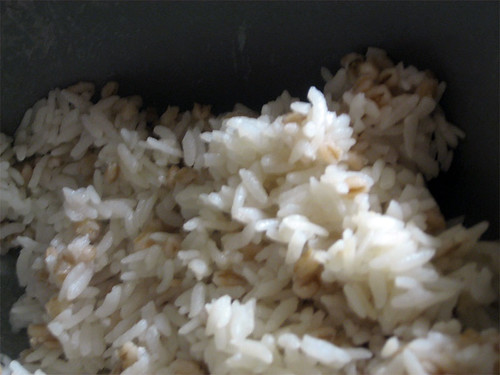
cute!
One of the experiences that got me growing curiouser about this food I grew up around was the first time I ate at David Chang's Momofuku Ssam Bar. The few times I've eaten there I experienced not only delicious food but something of a tasting adventure. That is what I get excited about — Tasting Adventures, not Great Adventure. Because I am scared of roller coasters and that scary dancing "old" man in the TV commercials.
Chang is of Korean descent but the influence comes out in accents and origins — the pleasure of the pork, the picklings, the apple slices (salted! mm) that come with the mochi. And he's also put in time at some of the big name restaurants, not to mention the whole ramen stint in Japan. There's brussel sprouts and banh mi, bread and butter and seasonal things on the menu. Calling Chang's food "Asian fusion" here seems to gloss over a lot. (The term "fusion food" is the quick path to Pandora's refrigerator box... let's leave it for another day.) Gourmet features him and a bunch of recipes in their October issue, and he says, "We don't categorize our food or ask, How can we make this Asian? We just want to make something delicious. It's American food." Hm.
Still, Chang's roots and his starry place in the NY restaurant scene did jumpstart my little porky brain thinking about the place of Korean cuisine in the landscape of American food culture — we don't have that much space in it, but we throw a freakin' tasty block party. It seems the majority of Americans are still unfamiliar with Korean food or are just getting to know it. (The irritating ones think they know Korean food after having some barbecue. You know the ones. They also love Thai food but only eat pad thai; they love Indian food but can only utter the words "curry" or "samosa." Yeah. Awesome.) But why is Korean food sort of in the alleyway, drinking alone? Food is a huge part of Korean culture, as in most Asian roots. We love to eat. It's almost made and market-ready — for "foodie" consumption especially. Because it's de-li-cious. And fun!
Other Asia-based cuisines have caught on more quickly. It's not only a matter of numbers/population. From what I understand, Japanese cuisine found easy attraction in traditional French-rooted culinary arts and vice versa, so that now, in the world of food-dom, French and Japanese sort of represent this "high" end. The Chinese, like the Japanese, have had a long history of immigration to the States and there are — Americanized and far from "authentic" as it is — like a gazillion Chinese places and a history of Chinatowns, which have greatly affected American acceptance. Thai and Vietnamese I know less about, but it's not a surprise that many of the top chefs today are influenced and inspired by and sure, enamored with the cuisines of Southeast Asia. With Indian cuisine — again, shaky on the history of this — the whole east-west thing was perhaps dealt with first in England (oh, colonialism) and perhaps that influence trickled to the States, not to mention the impact of another large influx of immigrants.
A lot of perception obviously has to do with who is running these restaurants (take Indian food as most Americans know it — it comes from one region, Punjab, in a large, super-populous nation, not to mention the surrounding areas of the subcontinent) and whether influential traditionally-Western public figures are paying attention, not to mention food "trends." I feel like much of this, especially in this day and age, comes down to publicity. Korean cuisine never got a spokesperson. (Nor am I sure we wanted one, at least in the early days.) There's no famous Korean food expert, no public figure, in cookbooks (of which there are like three) or in the media (food network, public television) or even on the internet (most, if not all, the korean food blogs I've seen are based in Korea). We have no Ming Tsai, Martin Yan, Iron Chef, Madhur Jaffrey. Even Asia-nut, Anthony Bourdain admitted on the Korea episode of No Reservations episodes that he wasn't very familiar with the cuisine. (Thanks for the idea for this blog title though!)
So, finally, that is partly why I'm so thrilled to have David Chang as this chef "celebrity." Sure he gets a lot of press. He doesn't even cook Korean food really. Yet, without that background, he wouldn't be where he is today.
So I wonder, what possibilities are out there for Korean food to have a bigger block party, and what is hip and trendy in Korean food in Korea that don't really make it over to the States? Or perhaps it does in little pockets (fried chicken anyone?). How many Koreans are there in the kitchens? (that sounds like a setup to a bad joke). Is Korean cuisine changing in the U.S. at all? Arrrrrr! SO MANY QUESTIONS! Time to go to sleep.
(Photo from merdiekristine's flickr)


